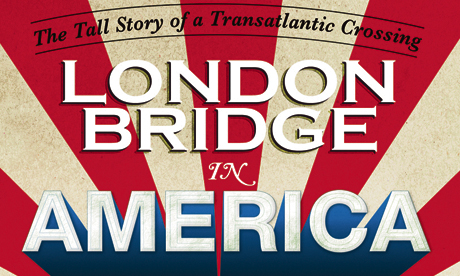London Bridge in America by Travis Elborough – review

London Bridge: the tall story of a Transatlantic crossing
Here’s a story beloved of open top bus guides and the cockney waterboatmen who ferry tourists from Cleopatra’s Needle to the historic attractions of Greenwich:
London Bridge — the one that was there before the current 1970s incarnation – now stands in the Arizonan desert. It was bought for a fortune by ‘dumb Americans’ who thought they were getting the rather more ornate Tower Bridge. Cue chuckles.
However, this yarn is only half true. The Americans in question were under no illusions about which river crossing they were coughing up for, but the unvarnished truth still makes for a funny tale, and it is told with panache by writer Travis Elborough.
Ever since there was a London there have been myths, stories and superstitions about its river and things connected with transpontine drift. I myself once made a minute contribution to this cannon via a short story in the now sadly defunct London fiction publication One Eye Grey.
As the settlement’s first fixed river crossing, London Bridge was a particular magnet for such lore. It is immortalised in the famous and vaguely threatening nursery rhyme and was a place where traitors’ disembodied heads were stuck on spikes.
Bridges also function as obvious metaphors, in this case for the transatlantic love affair embodied in the sensational sale of old London Bridge.
Elborough begins with the first London Bridge’s foggy origins in Roman times, when our city was but “a dunghill on the fringes of Europe” and shows how the structure was continually rebuilt and reinvented as society and technology developed, with today’s London Bridge a product of the fascinating brutalist architectural movement in the 1960s, which we learn owed much to Le Corbusier, the rise of the motor car and a fixation with city planning a la Las Vegas.
Elborough writes: “Across the pond, America, and Los Angeles especially – less a traditional city than an entire motorised region – had provided the template for automotive urban growth. Its tall
buildings, expressways and drive-ins, idealised in photographs, Hollywood movies and popular songs, presented an irresistible notion of unfettered mobility.”
Such thinking was revolutionising Britain in the 1960s and it shaped the country we live in today, I would argue for the worse, but it does at least seem fitting that the obsession with remaking London along American lines informed the City of London Corporation’s decision to flog London Bridge to the yanks.
The particulars of the sale in 1968 of what is described as “the world’s largest antique” are still shrouded in mystery.
Elborough points out that meeting minutes covering the bidding process remain confidential and the major players are now dead.
The author has a talent for going off on amusing tangents, which can at times be slightly annoying, especially when he seems as if he is involved in a contest to drop as many pop cultural references as possible in the course of a sentence. But his lively writing style makes him a great guide to the surreal world of Lake Havasu City, Arizona, the bridge’s final resting place, which he visits at the tail end of the book.
The bridge was transported to America at a time of US anglophilia and was flown 3,000 miles in pieces along with a flock of London pigeons which were released into the desert, and a mock English village was constructed on its channel-side.
Visiting this tacky reproduction over four decades later, Elborough concludes: “The whiff of decay was unavoidable.”
Times have changed, and it turns out the timewarped English Village is itself now listed for demolition to be replaced by a swish new shopping and leisure complex – perhaps a reflection of the fact that America is now far less fascinated by us, even if we still idolise the great United States.
London Bridge in America: The Tall Story of a Transatlantic Crossing by Travis Elborough is published by Jonathan Cape; RRP: £14.99
